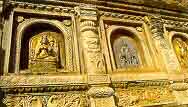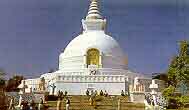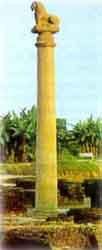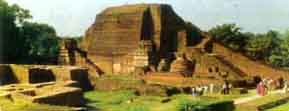| Pilgrim Places
| |||
From Siddhartha to Sakyamuni and finally to the Buddha or the Enlightened one - an incredible transformation of a prince to an enlightened teacher, who walked the earth more than 2500 years ago.
Upon seeing sorrow, misery, pain and death, in the prime of his youth, prince Siddharth decided to probe into their causes and find out means of overcoming their occurrences. Thus renouncing worldly pleasures and leaving home and family behind, he travelled from place to place until finally attaining enlightenment by fixed meditation under the Bodhi Tree. He then preached the truth he discovered, and exhorted his disciples to follow the eight-fold Path for the cessation of the endless cycle of birth and re-birth. Bodhgaya, in the state of Bihar, reckoned as the most important Buddhist pilgrimage centre, is the place where Lord Sakyamuni (Gautam Budhha) entered into meditation after being moved by the suffering of mankind. The giant Bodhi Tree (peepal) that we see today is believed to have grown from the original Bodhi Tree under which, sitting on the raised platform, Prince Siddharth meditated and finally attained Niravana. Then there is Chaukramana, the Jewel Walk, where it is believed that the Buddha strolled while in deep thought. |
More on Bihar • Overview • Bodhgaya • Gaya • Rajgir • Vaishali • Nalanda
Pilgrimage |
||
Bodhgaya
Adjacent to the Mahabodhi temple is the Shaivite Monastery that has a cluster of four temples. Surrounded by enchanting greenery and marked by architectural marvels, these temples have several samadhis (commemorative stones) in their vicinity. Just across are a number of cells, meant for residential purpose of monks. Not far from the Shaivite Monastery is the Jagannath Temple which is dedicated to Lord Shiva and has the statue of the deity, carved in glistening black stone. Finally, a visit to the Bodhgaya Archaeological Museum is a must for a religious art lover as it initiates one into the age of Budhha's centred art forms. The Budhhist sculpture collection from 1st Century B.C. to 11th Century A.D. is housed here at one place. Reflected through several art forms, it is more like a treasure house of artistic expression. Bodhgaya is 245 kms from Varanasi and 178 kms from Patna via Rajgir and Nalanda. A place of religious sanctity for Hindus, Gaya lies 12 kms from Bodhgaya between Pretshila and Ramshila hills and is washed by the shores of river Phalgu. Gaya has a large number of Buddhist temples also. While Buddha was doing severe penance, he was offered food by a condemned village woman named Sujata. To everybody's surprise Buddha accepted her offerings. Legend has it that after having consumed the food, Budhha's countenance assumed a divine glow and he realised the Supreme Truth that neither extreme self indulgence nor self mortification is ever required. What is needed is to follow the Middle Path. Sujata Sthan or Durgeshwari Temple stands as a symbol commemorating this event. In the vicinity of Bodhgaya, there are several other places of tourist interest such as the Surya Temple at Deo, 20 kms from Gaya; the Sun God Temple at Umya; the Konchishwar Maha Deva temple at Konch; Barabar Caves just 40 kms away; the Budhhist Rock-Cut Caves of 3rd Century B.C. at Sasaram, 123 kms away. Rajgir Many sites of historical and archaeological significance surround the holy city of Rajgir. Bimbisara Jail reminds one of the devoted Mauryan King Bimbisara (5th-6th Century B.C.) who, being a Buddhist, chose this as a place to spend his last days. From here he could see Buddha climbing up the Grihakuta Hill to do his meditation. Ajatashatru's Fort is another place of tourist attraction. The Sculpture which depicts the `Parinirvana ', or the `great cessation' of Buddha is another monument of artistic and historical importance. It shows the Buddha lying on his head to commemorate the final salvation or 'Mukti', of the great founder of the Buddhist Faith. Other prominent sites of importance at Rajgir include Saptdhara, the hot springs which supposedly have healing powers; Venuvan Vihara, the residence built by the king Bimbisara for Buddha; Jivaka's Mango grove, residence of an ardent Buddhist follower, Jivak, who was a surgeon; and the Karanda Tank, bathing site of Lord Buddha. Also the first Buddhist Council was convened here, at the Saptaparni Cave, after the Mahaparinirvana of Buddha. Patna lies 102 kms from here and 34 kms from here is Gaya.
Vaishali was also the centre of the IInd Buddhist Council congregation, held after 100 years of Buddha's Parinirvana to discuss the ten points of Vinaya, the rule of conduct under dispute. At the excavated archaeological site of Raja Vishal Ka Garh is an ancient parliament house, which indicates that this republic flourished in the 6th Century B.C. Vaishali is famous for Amrapali, the beautiful dancer and courtesan of Vaishali, who offered Buddha a mango orchard and, impressed by his teachings, became a nun (Bhikshu) in turn. The excavations carried out in Vaishali have brought to light Buddha Stupa I (4th Century B.C.) and II, built in brick with a casket contaning part of the ashes of Buddha. Other sites of historical importance in Vaishali include Chaumukhi Mahadeva, a lingam carved with four faces of Lord Shiva; the Bhawan Pakhar Temple, where a large number of Hindu deities are enshrined at one place and are worshipped together; Coronation Tank where the Lichhavi Kings were anointed before being crowned and; the Vaishali Museum which has a small collection of regional handicrafts, Also worth a visit is Kundupur, 4 kms from here which is the birth place of Lord Mahavira (6th Century B.C.) who spent 22 years of his initial years here.
|
|||
Editor: Romola Butalia (c) India Travelogue. All rights reserved. |
|||
 The magnificent Mahabodhi temple in Bodhagaya is an architectural amalgamation of many cultures. The temple bears the stamp of the architecture of the Gupta Dynasty and subsequent ages. On the walls of the temple, one sees Budhha carved in different aspects, and in the sanctum sanctorum, a colossal Buddha, is seen touching the ground, which has mythological significance in Budhhist lore. The temple carries inscriptions recording the visits of piligrims from Sri Lanka, China and Mayanmar in the 7th and 10th Centuries A.D. Hieun Tsang, the Chinese traveller, also visited the temple in the 7th Century.
The magnificent Mahabodhi temple in Bodhagaya is an architectural amalgamation of many cultures. The temple bears the stamp of the architecture of the Gupta Dynasty and subsequent ages. On the walls of the temple, one sees Budhha carved in different aspects, and in the sanctum sanctorum, a colossal Buddha, is seen touching the ground, which has mythological significance in Budhhist lore. The temple carries inscriptions recording the visits of piligrims from Sri Lanka, China and Mayanmar in the 7th and 10th Centuries A.D. Hieun Tsang, the Chinese traveller, also visited the temple in the 7th Century.
 Rajgir, meaning "the Royal Palace", (Raja Griha) lies 12 kms south of Patna. Rajgiri is a site of great sanctity and significance for Budhhists. The Gridhakuta Hill, in Rajgir, was the seat from where Buddha delivered many of his sermons. It was here that the teachings of Buddha were recorded in writing for the first time. An aerial ropeway takes visitors up the hill where the Japanese have built a beautiful Stupa.
Rajgir, meaning "the Royal Palace", (Raja Griha) lies 12 kms south of Patna. Rajgiri is a site of great sanctity and significance for Budhhists. The Gridhakuta Hill, in Rajgir, was the seat from where Buddha delivered many of his sermons. It was here that the teachings of Buddha were recorded in writing for the first time. An aerial ropeway takes visitors up the hill where the Japanese have built a beautiful Stupa.
 Vaishali, believed to be the first republic of the world, having an elected body of representatives, holds special significance for Buddhist devotees. At Kolhua, Lord Buddha delivered his last sermon, hinting at his impending departure from the mortal world. Later, Emperor Ashoka erected a huge pillar to commemorate the spot of the last sermon.
Vaishali, believed to be the first republic of the world, having an elected body of representatives, holds special significance for Buddhist devotees. At Kolhua, Lord Buddha delivered his last sermon, hinting at his impending departure from the mortal world. Later, Emperor Ashoka erected a huge pillar to commemorate the spot of the last sermon.
 Nalanda, 90 kms. south of Patna, literally means the place that confers the lotus. It was one of the Oldest universities of the world. It has nine million books, ten thousand students, two thousand teachers and was a centre of great learning which reached its Zenith between 5th and 12th Century A.D. Both Lord Buddha and Lord Mahavira visited this place. Emperor Ashoka built a Vihara, while Emperor Harshvardhan donated a 26 mtr. high copper image of Buddha and Emperor Kumar Gupta built a college of fine arts. In 1951, an International Centre for Buddhist Studies was established in Nalanda. Nava Nalanda Vihar, 2 kms from here, is a similar institution.
Nalanda, 90 kms. south of Patna, literally means the place that confers the lotus. It was one of the Oldest universities of the world. It has nine million books, ten thousand students, two thousand teachers and was a centre of great learning which reached its Zenith between 5th and 12th Century A.D. Both Lord Buddha and Lord Mahavira visited this place. Emperor Ashoka built a Vihara, while Emperor Harshvardhan donated a 26 mtr. high copper image of Buddha and Emperor Kumar Gupta built a college of fine arts. In 1951, an International Centre for Buddhist Studies was established in Nalanda. Nava Nalanda Vihar, 2 kms from here, is a similar institution.